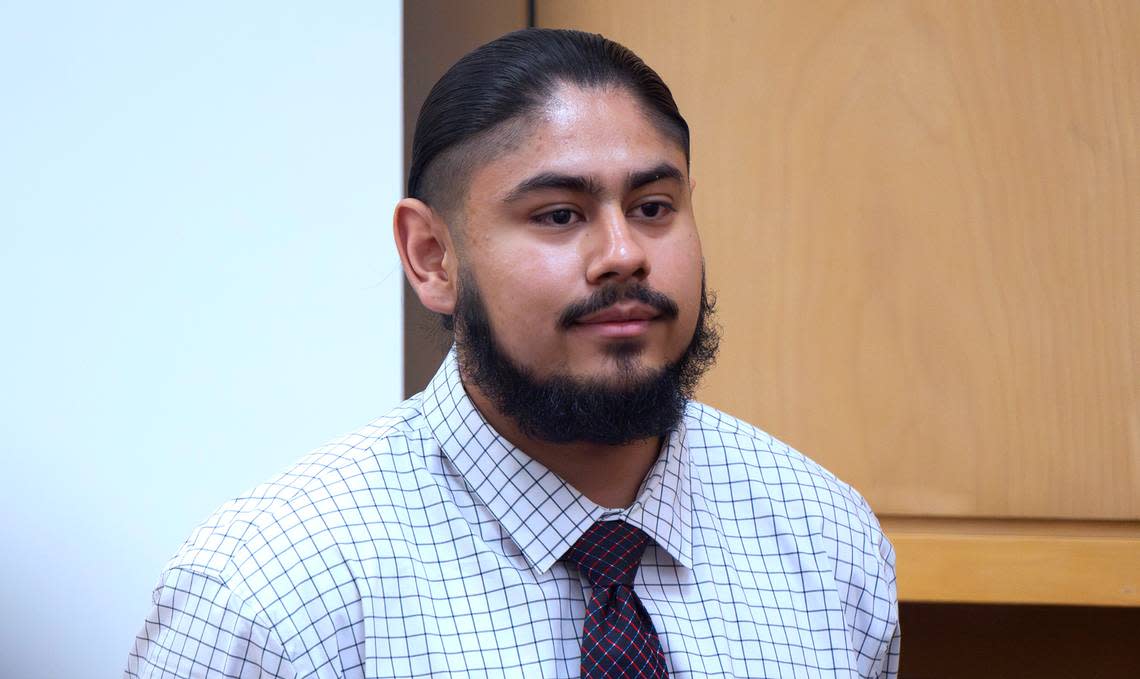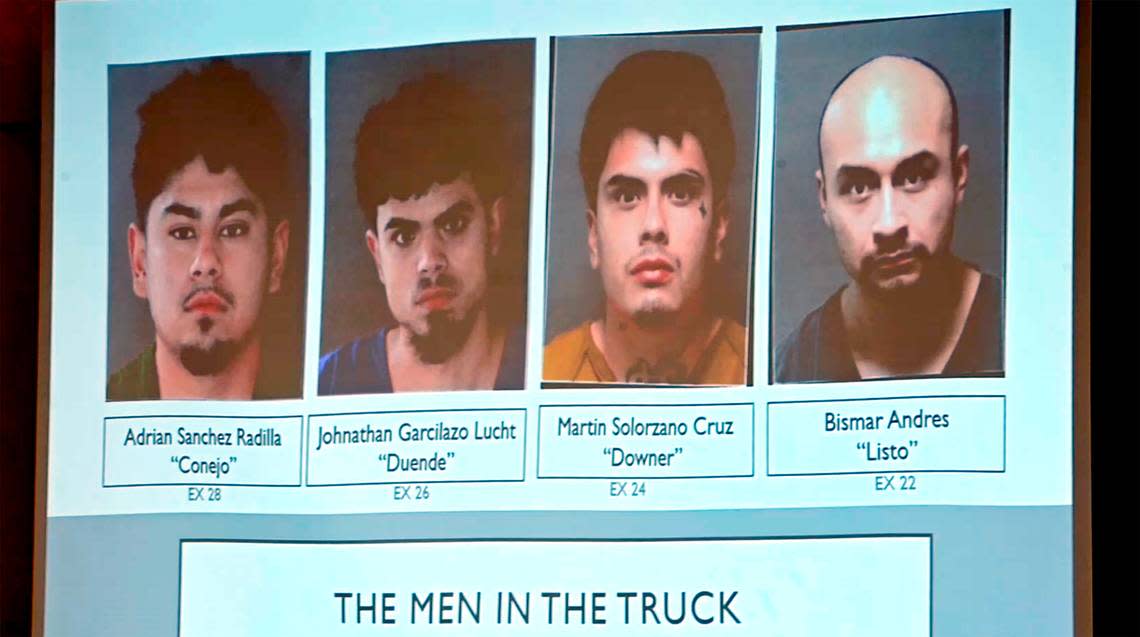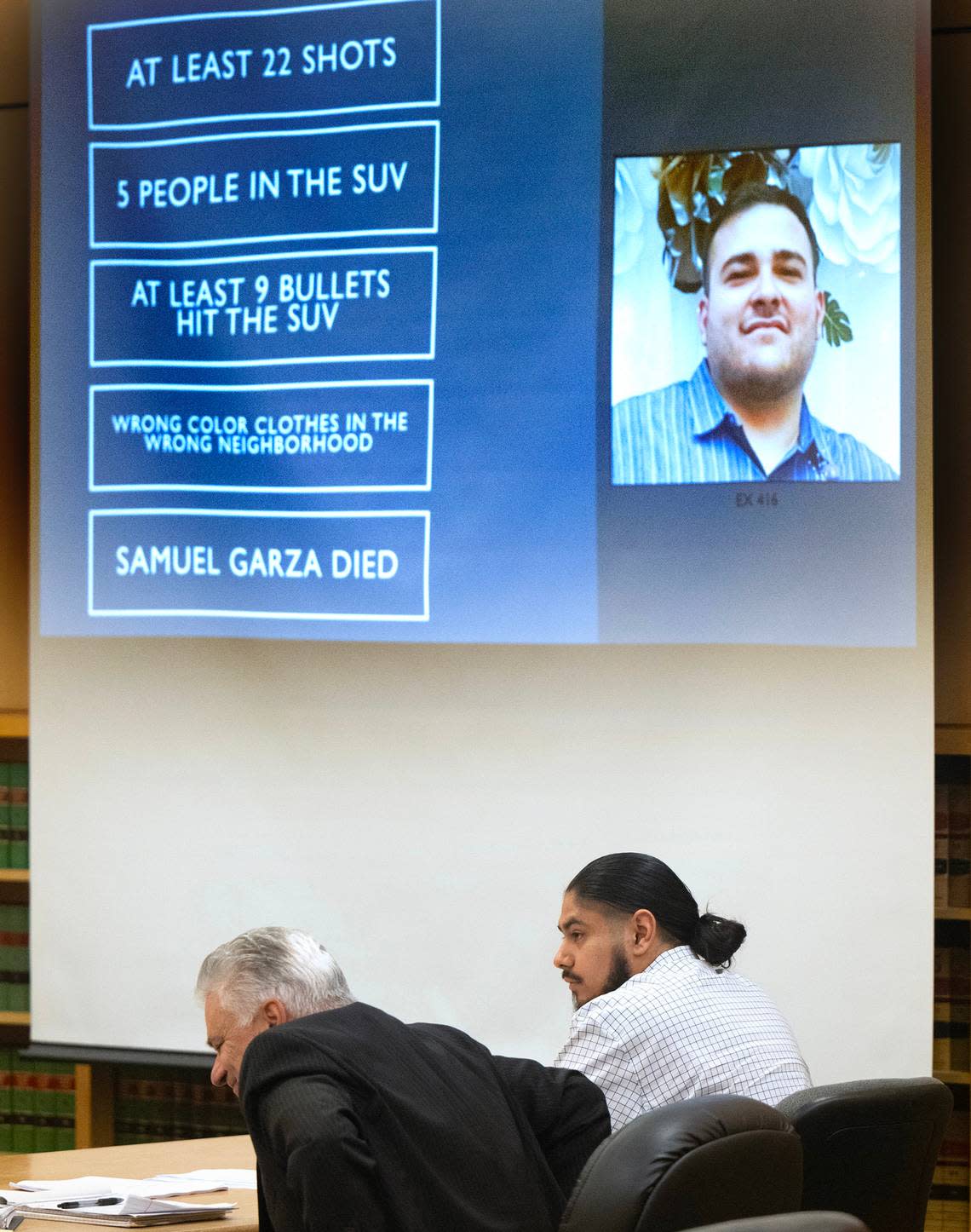Was Tacoma man killed by gangsters claiming contested territory? A jury has the case.
Samuel Antonio Garza Gonzalez, 24, wore the wrong colors in the wrong neighborhood, Pierce County prosecutors say. That’s why he was shot to death on May 7, 2022 on Tacoma’s Eastside.
Wednesday, jurors heard closing arguments in the case against Adrian Sanchez-Radilla, 26, one of four men charged in the fatal shooting. The other three — Martin Solorzano Cruz, 25, Bismar Andres, 30, and Jonathan Lucht, 26 — have already pleaded guilty to murder and await sentencing.
Now a Pierce County jury of six men and six women must decide whether Sanchez-Radilla is guilty of first- or second-degree murder, four counts of first-degree assault, drive-by shooting and unlawful possession of a firearm for allegedly taking part in the shooting.
Prosecutors said Garza Gonzalez was shot while trying to visit a relative in Eastside Tacoma with his wife, Nancy, his cousin, Gerrono Sandoval, and Sandoval’s two toddlers, then ages 2 and 3, who were seated in the back seat of the SUV that Nancy was driving.

After finding that the relative wasn’t home, the group drove toward a scenic viewpoint, then started to go home. Deputy Prosecuting Attorney Dru Swaim told jurors that they made a U-Turn, catching the attention of four men in a white pickup truck, later identified as the defendants.
Swaim said the defendants in the pickup were members of a street gang, one of several that were fighting to claim this territory as their own: the area of 34th Street and McKinley Avenue.
Driving behind the white pickup at about 11:10 p.m., Swaim said Garza Gonzalez told his wife to follow the vehicle, for reasons unknown to her. They followed the pickup for three to four minutes before the defendant’s vehicle stopped in the middle of the street at 401 E. 35th St. When the victims’ SUV rolled to a stop there about a minute later, Swaim said they were “ambushed” by the defendants.
Two shooters got out of the pickup, and in 10 seconds they fired at least 22 shots, striking the SUV nine times. One of the bullets hit Garza Gonzalez in the neck, and Swaim said he died in minutes. Prosecutors believe Sanchez-Radilla was one of the gunmen, along with Lucht, but they don’t know who fired the fatal bullet.
“It happened because they were being disrespected in their territory, and that disrespect could not stand,” Swaim said. “The SUV was hit nine times because they were wearing the wrong color in the wrong neighborhood.”
According to court records, Garza Gonzalez was wearing a red baseball cap when he was shot, and when the defendants’ vehicle was recovered by law enforcement, investigators found a blue bandanna wrapped around its steering column.

The fact that the defendants were gang members is important because if jurors find Sanchez-Radilla guilty of murder or assault, they must also decide whether he committed the crimes to obtain, maintain or advance his position in an organization such as a gang and that he did it to benefit the gang.
That aggravating factor could lengthen Sanchez-Radilla’s sentence. If convicted of first-degree murder, Sanchez-Radilla faces a minimum standard-range sentence of 20 years in prison.
To show jurors that the state proved the shooting was related to gang activity, Swaim turned to the testimony of an expert on gangs, Tacoma Police Department Sgt. Ryan Bradley, and another key witness, Cruz, who testified for the state after pleading guilty to his own involvement in the shooting.
Swaim said Bradley told jurors that the area where the shooting occurred is claimed by six different gangs, and he told them it is considered unacceptable for a gang member to do nothing about being followed in their own territory.
Cruz’s testimony was very similar, according to prosecutors. Swaim said Cruz told jurors from the witness stand that he and the others in the pickup became concerned when they saw the SUV make a U-Turn, and they shot at the car and left. He also spoke of the consequences that come with not standing up for your gang.
Sanchez-Radilla’s defense attorney, John Meske, spent much of his time in closing arguments trying to discredit Cruz’s testimony and arguing that the shooting was not related to gang activity.
Meske questioned Cruz’s motivations to testify on behalf of the state. He said the man pleaded guilty and got on the witness stand so he could go home.
“Is there no greater motivation than to lie or to minimize or to fabricate a statement than to get your get out of jail free card?” Meske asked the jury.
The defense attorney urged jurors to consider Cruz’s testimony carefully to see if he left anything out that could incriminate him. Meske recalled asking Cruz during trial where he told investigators he was seated in the pickup. According to Meske, Cruz said he was behind the front passenger, then quickly backtracked, stating that he forgot he was actually behind the driver.
Meske said it showed Cruz’s “selective memory.” He had trouble recalling where he was seated in the pickup but had no problem describing the hours leading up to the shooting, when he was hanging out with the other defendants in the vehicle, drinking tequila and smoking marijuana.
The seating arrangement in the car is a critical aspect of the case because the victim’s wife told investigators she saw a shooter get out of the passenger’s side of the vehicle, and a home surveillance camera that captured the shooting showed two gunmen standing on the passenger’s side of the truck.
Cruz testified, according to prosecutors, that he and the other defendants spent most of the day together in the pickup driving to Centralia and back to Tacoma, and their seating arrangements never changed. Andres was driving, Sanchez-Radilla was in the front passenger seat, Lucht was behind Sanchez-Radilla, and Cruz was behind the driver.
Meske contested DNA evidence and fingerprints that placed his client inside the pickup truck.
The pickup truck was recovered when Tacoma Police Department officers arrested Andres one day after the shooting in a high-speed pursuit that led onto northbound Interstate 5. Inside the truck, investigators found a can of Red Bull and a bottle of Mountain Dew that prosecutors said were purchased on the day of the shooting and contained Sanchez-Radilla’s DNA.
Fingerprints that prosecutors said belonged to Sanchez-Radilla and Lucht were also found near a passenger’s side door.
Meske reminded jurors that fingerprint evidence can’t determine when the contact occurred, and he said investigators were selective about what items to process in a vehicle full of different items that could be tested.
“Was that done in Chehalis?” Meske said. “Was the can of Red Bull there that was found crushed, was that can purchased in Chehalis?”
As for the state’s theory that this shooting was related to gang activity, Meske described it as a “misdirection” meant to stoke their emotions. And if Sanchez-Radilla had carried out the shooting to elevate or maintain his status in a gang, Meske suggested that he would have posted about it online or told someone else about it. He said no evidence was presented to show that happened.
The shooting wasn’t an ambush, Meske said, it was an inappropriate response to a perceived threat. And, arguing that Sanchez-Radilla was not guilty of assaulting the four other people who were in the victim’s car, Meske said there was no evidence anyone but Garza Gonzalez was harmed in the shooting.
“The fact is nobody knew who was in each other’s car, and nobody knew that there was any color on anything like that,” the defense attorney said. “So this theory of gang involvement is again, a misnomer.”
In the state’s rebuttal closing arguments, deputy prosecuting attorney Sunni Ko said “overwhelming” circumstantial evidence placed Sanchez-Radilla in the pickup. And she asked jurors to consider whether it made sense to shoot at an SUV in a neighborhood just because it was following you for a few minutes, unless gangs were involved.
“Does it make more sense, and is it more reasonable to believe they recognized that perhaps people in that vehicle may be gang-affiliated, people trying to disrespect their territory, and they want to show their muscle power by showing them who is boss on Eastside?” Ko said.
She said prosecutors knew for a fact that the Red Bull can with the defendant’s DNA on it was purchased at 11:08 p.m., and the probability of the defendant not being in the car for the shooting six minutes later was unlikely.

Ko balked at Meske’s suggestion that no one else in the victim’s SUV was assaulted in the shooting. She recounted what Garza Gonzalez’s wife told jurors of her reaction to the shooting, including how their cousin in the backseat, Sandoval, was crying hysterically, with his finger in the bullet hole in Garza Gonzalez’s neck trying to stop the bleeding, and how he clutched at his own children.
“No one else in that car was assaulted?” Ko said.
After the state’s rebuttal argument concluded in the mid-afternoon, Superior Court Judge Edmund Murphy temporarily dismissed one alternate juror, and the remaining panel of 12 began their deliberations.
Jurors will continue to deliberate Thursday.
